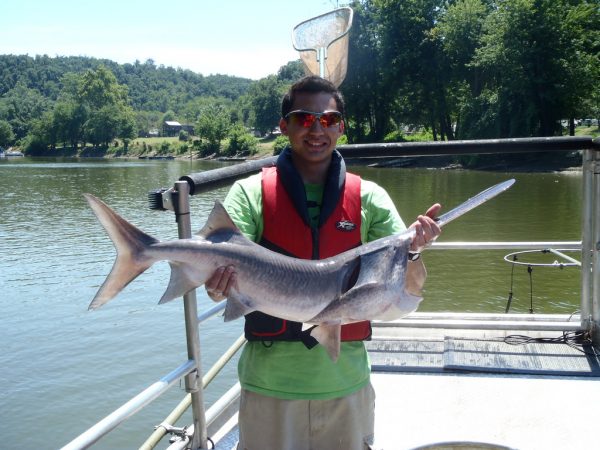Contrary to popular belief and news coverage, the alligator gar isn’t the only long-nosed outsider in the freshwater fishing world. The American paddlefish is not a frequent talking point on many lakes and rivers, but those who understand the paddlefish regard it highly in sport and ecology.
The paddlefish is considered to be a “primitive species” because few morphological changes have been documented dating back to its earliest fossils from the Late Cretaceous period, approximately 75 million years ago. Members of the polyodontidae famil are all North American with the exception of the genus psephurus, which includes solely the Chinese paddlefish.
The American paddlefish commonly grows to five feet and 60 pounds, but it is strictly a filter feeder, with zooplankton, insect larvae, small insects and small fish being its only diet. Scientists believe the fish uses its paddle-like nose, or rostrum, to dig up bottom substrate to find food sources. Electroreceptors on the rostrum’s hair cells help to detect prey like zooplankton in the water column.
The record American paddlefish weighed 144 pounds, but its Chinese cousin has been recorded at 23 feet long and several thousand pounds.
RELATED: Huge Alligator Gar Caught in Oklahoma
Throughout its historic range, the paddlefish has suffered population decline due to overfishing, pollution and the construction of dams that block ancestral migration routes. They have been extirpated from the Great Lakes and Canada. The Chinese paddlefish is believed to be extinct, with no known sightings in the wild since 2003. The American paddlefish is classified as vulnerable on the International Union for the Conservation of Nature (IUCN) Red List.
Paddlefish do not spawn until they are typically seven to ten years old, and females only spawn every second or third year, while males spawn every year or every other year.
Reservoir ranching and pond rearing have improved reproductive success, and in turn, a global market for the fish has grown. Many are raised in carp ponds and sold to restaurants, while many more are cultured for caviar production.
One particular success story is in Oklahoma, where the Oklahoma Department of Wildlife Conservation has introduced an initiative to bring money into the state’s paddlefish programs. In Miami, Oklahoma, at the Paddlefish Research Center, anglers can bring their freshly caught paddlefish to be cleaned for free, with the department in turn taking the roe and selling it to a market that is suffering from a shortage of traditional European beluga caviar. The profits are redistributed back into the department’s research efforts.
Also worth noting, if you’ve ever heard someone talking about a species of fish called a “spoonbill,” they’re referring to the paddlefish. Any ornithologist can tell you that the real spoonbill is a bird, but the striking similarity between the bird’s beak and the fish’s rostrum make it an understandable mix-up.
Photo credit: Flickr








